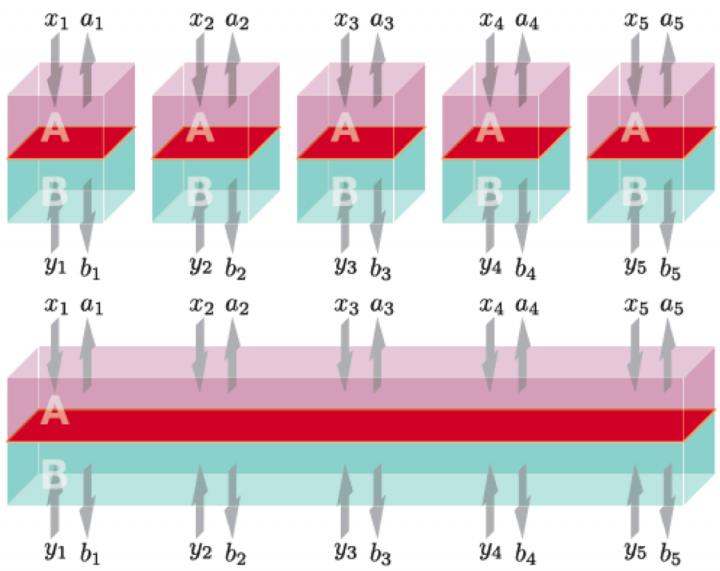Trust is good, quantum trickery is better

The key to proving the security of device-independent quantum cryptography in a regime that is attainable with state-of-the-art quantum technology is the realization that any attack strategy, no matter how complex (symbolized in the lower row), can be decomposed into a sequence of simple steps (upper row). (Image from Arnon-Friedman et al. Nature Comms 9, 459; 2018)
In quantum cryptography, the laws of quantum mechanics are exploited to send messages with higher security than is possible in conventional cryptographic schemes based on classical physical phenomena. In principle, quantum communication enables absolute security — that is, no adversary can intercept messages or tinker with them.
But in practice such unconditional security is not realizable. One main route for an unauthorized person to 'listen in' is to manipulate in advance the communication devices that will be used later.
Writing in Nature Communications, Rotem Arnon-Friedman and colleagues prove that there exist quantum-cryptographic protocols that ensure nearly optimal security even if the devices are manipulated, and that such device-independent quantum cryptography should be possible with current quantum technology.
Device-independent quantum cryptography is the 'gold standard' of quantum communication, as the advantages of quantum cryptography over its classical counterpart can be realized without having to worry whether the device used can be trusted or not. This is an appealing prospect, but so far device-independent quantum cryptography has been mostly a theoretical construct, with experimental requirements that are not achievable under realistic conditions.
Therefore the appeal of the new work of Arnon-Friedman, a PhD student in the group of Prof. Renato Renner in the Institute of Theoretical Physics at ETH Zurich, and co-workers in the US, France and the Czech Republic. The team developed a new theoretical concept, dubbed 'entropy accumulation', and applied it to quantum cryptography.
They find that any attack strategy, no matter how complex, can be decomposed into a sequence of simple steps. This is very helpful for security proofs, which are notoriously hard because every possible attack strategy that an adversary may conceive has to be taken into account.
With their new approach, Arnon-Friedman and her colleagues now prove, for the first time, the security of device-independent quantum cryptography in a regime that is attainable with state-of-the-art quantum technology, thus paving the way to practical realization of such schemes.
###
This work is a collaboration including scientists at ETH Zurich (Switzerland), the California Institute of Technology (US), École Normale Superieure de Lyon (France), Université de Lorraine (France) and Masaryk University (Czech Republic).
Media Contact
All latest news from the category: Physics and Astronomy
This area deals with the fundamental laws and building blocks of nature and how they interact, the properties and the behavior of matter, and research into space and time and their structures.
innovations-report provides in-depth reports and articles on subjects such as astrophysics, laser technologies, nuclear, quantum, particle and solid-state physics, nanotechnologies, planetary research and findings (Mars, Venus) and developments related to the Hubble Telescope.
Newest articles

Durable, Efficient, Sustainable: The Rise of Cerium Oxide Thermal Switches
Groundbreaking cerium oxide-based thermal switches achieve remarkable performance, transforming heat flow control with sustainable and efficient technology. Cerium Oxide-Based Thermal Switches Revolutionize Heat Flow Control Thermal switches, which electrically control…

How Industrial Robots are Reducing Emissions in Global Manufacturing
A new study explores the intersection of industrial automation and environmental sustainability, focusing on the role of industrial robots in reducing the carbon intensity of manufacturing exports. The research demonstrates…

Patients Can Heal Through Precise, Personalized Bioceramic Grafts
A recent review is transforming the landscape of craniomaxillofacial bone regeneration with the introduction of personalized bioceramic grafts. This pioneering research explores the fabrication and clinical potential of synthetic grafts…



